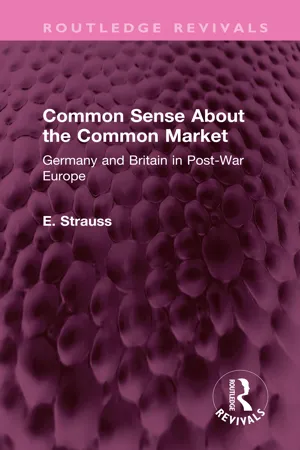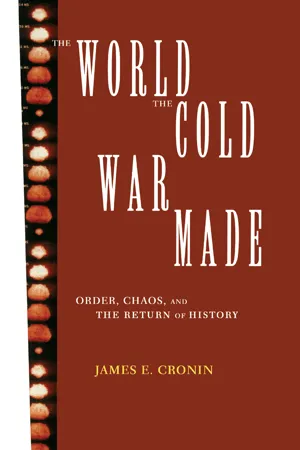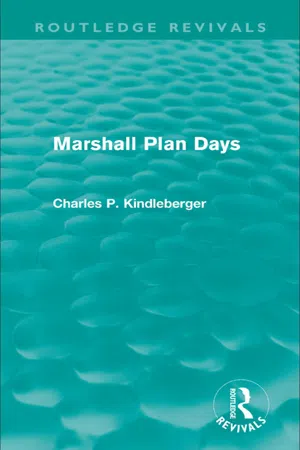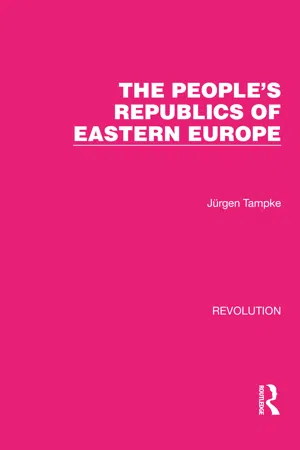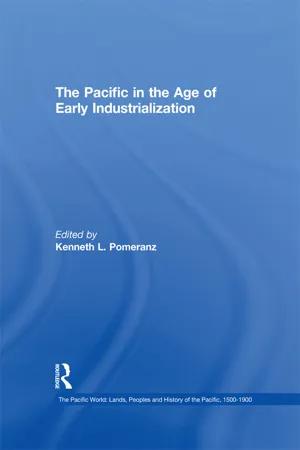History
German Economic Miracle
The German Economic Miracle refers to the rapid reconstruction and growth of the West German economy after World War II. This period of remarkable recovery, which occurred from the late 1940s to the early 1960s, was characterized by significant industrial production, export expansion, and a surge in living standards. The implementation of economic policies, such as the currency reform and the Marshall Plan, played a crucial role in this transformation.
Written by Perlego with AI-assistance
Related key terms
Related key terms
1 of 4
Related key terms
1 of 3
7 Key excerpts on "German Economic Miracle"
- eBook - ePub
Common Sense About the Common Market
Germany and Britain in Post-War Europe
- E. Strauss(Author)
- 2022(Publication Date)
- Routledge(Publisher)
III GERMANY’S ECONOMIC RE-ASSERTIONEconomic miracles are part of the German tradition, but so are political catastrophes. The first of these miracles was the quick rise of German industry to first place in Europe at the end of the nineteenth century, which transformed the label ‘Made in Germany’ from a warning into a boast. It was followed by the catastrophe of World War One, with its sequel of chaos and galloping inflation. Within a few years of the stabilization of the currency in 1924 people talked again about a German miracle, for Germany rode on the crest of a wave of sham-prosperity, until it was engulfed by the Great Depression; this destroyed the Weimar Republic and gave birth to Hitler’s Third Reich which performed the third economic miracle in the annals of modern industrial Germany by conquering unemployment in the name of ‘guns before butter’.When the Nazi millennium had run its course with six years of war preparations and six years of World War Two, Germany seemed to be past the stage when even a miracle could be of any use. Those of its young men who had not lost their fives on battle fronts ranging from the Atlantic to the Volga and from the Arctic to North Africa were cooped up in prison cages; its towns had been ruthlessly bombed from the air and fought over by hostile armies, and not a square foot of its territory remained free from enemy occupation. Millions of Germans from the territories annexed by Russia and Poland, from Czechoslovakia and the Balkans were expelled from their homes and converged towards the rump of the unhappy Fatherland, whose people had earned the reward of claiming to be the master race by becoming the pariahs of Europe.Nor seemed the future to hold out any prospect of recovery. The division of the country between Russia and the western powers foreshadowed the loss of independent nationhood for an indefinite period. Few Germans had any illusions about the intentions of the Russians, who could be relied upon to exact fearful retribution for the savageries committed on the Russian peoples in the name of Germany, but although the western powers appeared by comparison as the lesser evil, their policies did not seem very encouraging to the defeated Germans. The Americans advocated the ‘pastoralization’ of the country which involved the permanent destruction of Germany’s most valuable industrial assets; the British were credited with the intention of wanting to finish once for all with a dangerous trade rival, and the French were grimly determined to lop off large parts of Germany in the west in order to match the Russo-Polish amputations in the east, and to insist on strict decentralization of the rest. No reputable German man of affairs would have dared to predict in 1945 the solid prosperity of Western Germany in 1955, and still less its commanding creditor position in the Europe of 1957, and the victorious allies would have brushed aside such prophecies as wicked nonsense. - eBook - ePub
The World the Cold War Made
Order, Chaos and the Return of History
- James E. Cronin(Author)
- 2021(Publication Date)
- Routledge(Publisher)
Betriebsverfassungsgesetz (Works Constitution Act) of 1952 was, however, much weaker than the earlier legislation. The unions got at best a third of the slots on boards of directors, and works councils had a much restricted mandate.Labor, then, was poorly positioned in the early years of the republic. Lacking effective control over the market for labor and with but a weak voice within industry, the unions were unable to make significant progress toward their proclaimed goal of economic democracy. Ironically, the weakness of labor undoubtedly aided economic recovery and, in the long run, may have been of more benefit to workers than greater representation or higher wages granted in the context of a less rapidly growing economy. The Wirtschaftswunder was a classic instance of export-led growth: the rate of growth of exports (13.5 percent) far outpaced that of the economy (8.9 percent) and of private consumption (7.8 percent) in the 1950s.26 The pattern continued, enabling the German share of world exports to grow from 3.7 percent in 1950 to 10 percent in 1970.27 Part result and part cause of this process, productivity rose faster than wages and unit labor costs went down steadily. Stable or declining costs were an ongoing spur to exports and led to further growth.Economic growth ultimately led to rising real incomes and increased consumption, but with a considerable lag. The economic miracle was in this crucial respect built upon the willingness, coerced or freely granted, of workers to postpone improvements in the standard of living. Even so, the success of the miracle was not guaranteed by the labor market or by the institutional framework of the “social market economy.” It rested as well on two further foundations. First, growth resumed in the early 1950s due largely to the boom in world trade sparked by the Korean War. Second, Germany was better able to take advantage of the boom because of the enormous spare capacity of industry. A good portion of the capital stock was a product of the Nazis’ incredibly successful buildup of the war economy. As of 1950, manufacturing industry was utilizing only three-quarters of its capacity and was therefore capable of rapid expansion. Expansion was also made possible by a more than ample supply of skilled and trained labor at what amounted to a bargain price.28 There has been some reluctance to acknowledge the contribution of U.S. military spending to German economic revival and even more resistance to the notion that Nazi investment policies laid the basis for the Wirtschaftswunder. Erhard himself, for example, argued strongly that the Korean War hurt rather than helped the economy, and that it was the institutional framework of free enterprise, not the de facto Keynesian stimulus of the Korean War that was responsible for long-term growth.29 - eBook - ePub
- Michael Balfour(Author)
- 2004(Publication Date)
- Routledge(Publisher)
In addition the return obtainable on investment is likely to rise, making it more attractive in comparison with other uses of money and hence stimulating it. The essence of the German ‘miracle’ was that at a time when world demand was high, German industry found itself with spare capacity, the right products and relatively low costs, so that exporting was easy and profitable, and hence popular. Once this export-led expansion got under way, the prospect of making profits attracted investment into export industries whose growing earnings made it easy to pay for all the imports which increasing manufacturing for export involved. The pool of unemployed, continually refilled until 1961 by migrants from East Germany, for a long time prevented shortage of labour from constricting output. Thanks to the high rate of investment, production grew at a rate which allowed for ample increases in prices and wages without inflation. The exchange rate remained favourable (in spite of being devalued less than most other European currencies in 1949 and being up-valued in 1961 and 1969) and the costs of West Germany’s competitors mostly rose faster than hers did (to say nothing of the fact that she sold on quality and servicing as much as on price) so that she could afford increases without pricing herself out of the market. All in all, she was in the exceptional and fortunate position of a ‘virtuous spiral’ (such as Britain enjoyed between 1750 and 1850). Neither the old Reichsmark nor the new Deutschmark was a ‘reserve currency’ and West Germany was not under any obligation to provide other countries with capital. Indeed the authorities put up interest rates to check home demand with the result that, in spite of a big export surplus, money flowed into rather than out of the country - eBook - ePub
- Bernard H. Siegan(Author)
- 2017(Publication Date)
- Routledge(Publisher)
Modern economists could only look with bewilderment at the hazardous German experiment. To avoid revisions of established modern theories, they have advanced various special explanations for the German miracle:The large number of refugees—once widely accepted as an excuse for the failure of planning before 1948—are now presented as a decisive factor of economic growth. No explanation is given why they were such a factor only in the market economy after 1948, and why not before that time in the system of central planning.Foreign aid is also mentioned. But while foreign aid was certainly important, it could not explain the better performance of the West Germany economy as compared with similar countries receiving the same or even more aid.Even government planning itself has been adduced to explain West German economic development. In some senses not intended by its advocates, this thesis might have some validity, and we will analyze it presently.Another argument has been that the surplus of labor undermined the bargaining power of the trade unions. Although this is true to some extent, real wages increased rapidly, often more rapidly than in other countries.Some critics predicted that Germany would face the familiar “British” problem of excess demand, when the country reached full employment and the inflow of labor from the East had dropped (which happened after the comple tionof the Berlin Wall in 1961). Again the prophecy turned out to be ill-founded: West Germany managed to sustain high growth rates and extremely low rates of unemployment for another decade from 1960 to 1970 (interrupted only briefly by the recession of 1967). During this period, the price index rose at a rate which, although high by recent German standards, was idyllic in comparison with other countries. Increased inflation, however, did not result from rising internal costs, but from inflation imported from abroad through a large export surplus—an inflation which Germany tried to avoid by several revaluations of the DM. The inflation did not change its imported character before 1970, at which time the social market economy was gradually replaced by another style of economic policy. - eBook - ePub
- Charles P. Kindleberger(Author)
- 2009(Publication Date)
- Routledge(Publisher)
From all points of view, however, German recovery thus far has been useful and welcome. This recovery, as you probably know, has partaken of the nature of a miracle. Steel production has doubled in a year; coal output has increased by 50 percent over the same period; industrial production as a whole has risen from 50 percent of the 1936 average in June 1948 to 80 percent in February 1949. Farm output has increased somewhat, and crop collections, though still unsatisfactory, more. The most impressive improvement is perhaps in exports, and within their total, in exports other than coal. Total exports have risen from approximately $160 million in 1946 to $750 million in 1948. At the end of the year they were going forward at the rate of $850 million annually. Exports other than coal amounted to something of the order of $40 million in 1946. They are currently approaching that figure monthly.Is this miracle a fact? For the most part, it is. There was serious underreporting in the offcial statistics prior to the monetary reform of last June. Some part of the recovery represents simply a shifit of illicit production into the offcial figures. In exports, moreover, the final success of the army in liquidating the “defcit” of $362 million that developed from the cashing of local currencies by American troops in Germany, Austria and Japan1 has diverted a stream of dollar services formerly produced by Germany for the Department of the Army as occupation costs into the category of exports. For the most part, however, the miracle is real.What has caused the miracle? The answer to this question is a little more complex. It is hard from this distance to give exact weights to the factors involved; but they are, roughly in the order of their importance: the monetary reform of 20 June 1948; the Berlin blockade; United States assistance to the Bizone beyond the disease-and-unrest formula; and increasing German responsibility for the bizonal economy combined with increasing German unity and purposefulness, not to say nationalism. The monetary reform is occasionally given all the credit. There can be no doubt it was of great importance. The exchange of 100 Reichsmarks for Deutsche marks, of which the J - eBook - ePub
- Jürgen Tampke(Author)
- 2022(Publication Date)
- Routledge(Publisher)
5 THE GERMAN DEMOCRATIC REPUBLIC: ECONOMIC MIRACLE?For the GDR the 1950s continued to be a decade beset with difficulties. The divided Germany in the heart of Europe became the centre of the West-East confrontation not only in terms of Cold War arguments about reunification and Berlin but also in terms of outright economic competition. Here, in full view of the world, one part of Germany was undergoing reconstruction along capitalist lines while the other followed a socialist course. Not surprisingly it was the GDR government’s avowed aim not only to match but indeed surpass the economic performance of West Germany. There was no chance for this to happen quickly.1 The vastly different starting conditions soon ensured that the Federal Republic surged ahead. This is not to say that the GDR’s economic performance was unimpressive. The contrary was true. With relief from the burden of reparations and with the transfer of the Soviet-run joint stock companies in 1953,2 the GDR economy maintained a steady growth rate. The target figures for the first five-year plan were largely fulfilled and in the wake of the reforms following the July 1953 confrontation, living conditions by 1955 had risen by one third compared to 1950, although there still remained a considerable shortage of consumer goods. The second five-year plan for the years 1956-60 specified an increase in gross national production of 55 per cent. Priority was given to the development of lignite, power and chemical industries. Plan targets were completed by 1958, two years ahead of schedule. The most notable achievement was the construction of the Kombinat Schwarze Pumpe which became the world leader in the production of brown coal. Production of consumer goods was also increased and the overall ‘surprisingly favourable economic development’3 - Kenneth Pomeranz, Kenneth Pomeranz(Authors)
- 2017(Publication Date)
- Routledge(Publisher)
1The European Miracle and the East Asian Miracle: Towards a New Global Economic History (1)Kaoru Sugihara1. Introduction
Table 1 Per capita GDP in Selected Countries, 1820–1992 (in 1990 Geary-Khamis dollars)This paper discusses several ideas on how to locate the European miracle and the East Asian miracle in global history. Many authors have compared the European and Japanese “miracles”, by defining them in various ways. One line of comparison has been to focus on economic growth. For those who take growth accounting seriously and believe that per capita GDP remains the best indicator of economic welfare, the period of Japanese high-speed growth (1955-1973) does stand out as historically unique. A sustained annual growth rate of around 10 percent for this long a period had never occurred elsewhere (see Table 1 ). The same table also suggests that the Japanese miracle was in fact the beginning of an East Asian miracle in which a number of other Asian countries have begun to participate during the last twenty years or so.(2)On the other hand, according to this table, the Japanese (and the East Asian) record prior to 1945 is not at all impressive, compared to those of advanced Western countries. If there is a story to be told of a miracle or miracles, it should surely be focused on Britain for the period up to 1870, and on advanced Western countries between 1820 and 1950. Furthermore, Table 2
Index pages curate the most relevant extracts from our library of academic textbooks. They’ve been created using an in-house natural language model (NLM), each adding context and meaning to key research topics.
Explore more topic indexes
Explore more topic indexes
1 of 6
Explore more topic indexes
1 of 4
